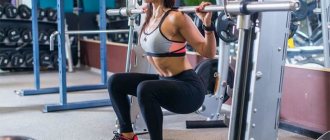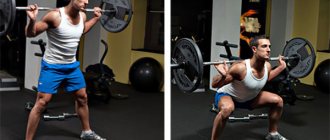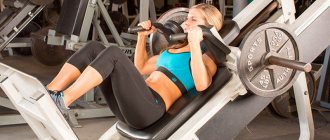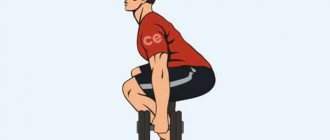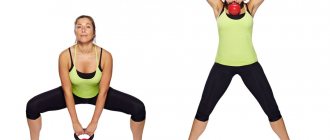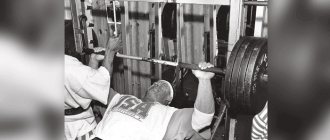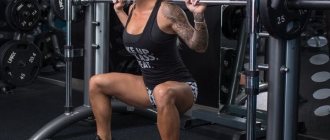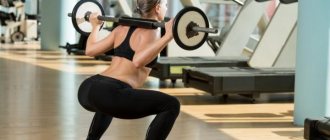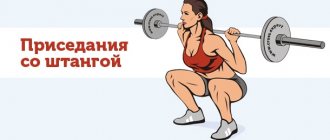The Smith machine kneeling squat is an exercise in the fitness bikini arsenal. It specifically works the gluteal muscles and minimally involves the hips. There is something similar in shaping, only without the weights. The movement is popular among practitioners for aesthetics, and requires high-quality execution. If you do it incorrectly, you can get injured, despite the ease of the exercise itself.
Execution technique
Original
- Set the bar of the machine at a height at which it will be convenient to remove the weight if you are kneeling;
- Lay down the rug;
- Place your knees hip-width apart and slightly wider, pointing your hip bones to the sides;
- Get down on your knees;
- Place the crossbar of the exercise machine in the middle of the trapezoid;
- Tighten your back, lower your shoulder blades towards your pelvis, tighten your stomach;
- Rotate the Smith Bar by hand and remove the weight from the supports.
Movement
- Lower your buttocks between your shins, as if squatting from your knees;
- Don't point your knees forward;
- Choose a comfortable amplitude at which the ligaments do not hurt;
- Perform the reverse movement by extending the hip joint;
- At the top point, statically tense your buttocks if this does not cause discomfort;
- Do not relax your stomach throughout the exercise.
Smith Kneeling Barbell Squats
Attention
- The knees should be slightly pushed forward, and not directly under the bar. This will help avoid ACL injury;
- Do not direct your thighs parallel to each other and forward; this position creates a dangerous load on the knee and hip joints;
- The abs should be kept contracted and the stomach tucked. Relaxing the muscles in this case does not help the process much. On the contrary, it can cause injury;
- Don't relax your back, don't lower your head to your chest, and don't look at the floor.
Benefits of Smith Squats
Smith machine squats have several advantages over regular squats with free weights, that is, with a loose barbell. These include:
- ease of maintaining the correct technique due to the absence of the need to maintain balance;
- preparing muscles for performing squats with free weight;
- placing the load exactly on the target muscle;
- the ability to use much larger scales;
- minimizing the risk of injury;
- no need for insurance from the partner;
- the ability to perform squats even with back problems.
Due to this, squats in the Smith machine are suitable for beginners to practice technique and strengthen the muscular frame of the lower body.
When performing squats on a Smith machine, many muscles are used. First of all, these are quadriceps, buttocks, hamstrings and calves. The press receives a small load.
But this exercise also has its disadvantages. They partly follow from its merits. When performing Smith squats, the back muscles and stabilizers are not loaded and therefore not strengthened. This may lead to future injuries.
Therefore, in parallel with doing squats, it is recommended to do exercises for the back and lower back (traction, hyperextension, etc.).
Recommendations
- There is an effective range of motion in this exercise. If you want to stick with it, lower your buttocks completely to the floor. You won't be able to stretch the muscle if you sit on your calves. For this reason, the movement is not suitable for people with large hamstrings;
- You can either stretch your feet completely or put your foot on your toes. If you experience discomfort, take off your shoes, it will be easier;
- The bar should not be placed high on the neck;
- If you don't feel the strain, you can do a couple of sets with a rubber shock absorber around your hips;
- Lift from the bottom position quickly, but lowering can be made longer
What muscles work in the exercise
Smith machine squats are an exercise for pumping up leg muscles, which is a basic movement.
The main load here falls on the quadriceps . Supportive role in the hips and gluteal muscles.
The psoas muscles and abs act as stabilizers of the torso.
A distinctive anatomical feature of the exercise is that the Smith squat excludes from the movement small stabilizer muscles that help keep the body in an upright position.
Flaws
- Cannot be used as an exercise for building muscle mass, as it does not allow the use of significant weights;
- Not recommended for those with problems with the spine and joints;
- Can cause ACL injury, especially if the ligaments are overloaded with a large amount of cardio and the body as a whole is depleted by diet;
- Not available for large hamstrings or poor mobility;
- Cannot replace basic exercises for those who are underweight;
- Carries a high risk of injury if performed carelessly;
- It can provoke inflammatory processes in the hip joints, especially if the athlete performs a large volume of training load on the buttocks.
Pros and cons of the movement
Smith machine squats are a unique exercise. Indeed, during different training periods, the same properties are both positive and negative.
Among the advantages of the exercise we note:
- Promotes muscle growth and leg strength
- Reduced risk of injury compared to classic barbell squats
- Has much less negative impact on joints and ligaments involved in movement
- A given trajectory of movement, thanks to which you can fully concentrate on working the target muscles
- Relatively easy to perform technically, compared to classic squats
- No need for insurance or assistance from a partner or assistant
The design of the simulator includes safety hooks. And some models of the Smith machine also have lower limit stops, which ensure the safety of the exercise.
Oddly enough, the advantages of squats in the Smith machine directly turn into its disadvantages:
- Less likely to increase muscle mass and leg strength than similar barbell movements
- The Smith machine does little to strengthen the ligaments and tendons that are essential for effective squatting.
- Due to the exclusion of stabilizer muscles from work, there is no direct transfer of technical and strength skills to exercises with free weights
For example, a barbell in Smith that a person works with can weigh 150 kg. But if this weight is placed on a regular barbell, the athlete is unlikely to cope with it.
It's all about the stabilizers, which must be trained to perform classic squats, and which practically do not develop in the Smith machine.
Inclusion in the program
You should not include this movement in the training process more than once a week. The reason is increased load on the ACL. It's best to do knee squats on a day when you don't squat or press your legs.
Ideal - after Romanian deadlifts with medium weight as 2-3 exercises. You should not perform the movement in a power mode; it is better to do 8-12 repetitions in 3-4 approaches.
The movement should be performed alternating with a front-loaded kneeling squat (holding a dumbbell on the chest). This will help protect the ACL from overload and diversify your training.
Read also[edit | edit code]
- Hack squats
- Seated bench press
- Bench press
- Barbell Squat
- Squats with a barbell for girls
- Front Squats
- Squats with a barbell on your shoulders
- Wide-legged barbell squats with barbell
- Front squat with barbell
- Squats with dumbbells
- Front squat with dumbbells
- Performing plie squats with a dumbbell between your legs
- Squats with ball between legs
- Deep squats
- Squats on a bench
- Sumo squats
- Wide-legged barbell squats
- Sissy squats
- Hindu squats
- Shoulderstand squats
- Jackknife squats
- Supported squats
- Full and partial squats (on one leg)
- Narrow and uneven squats
- Supported squats
- Supported single leg squats
- Single leg squats
- Single leg squats on a bench
- One-leg squat with ball support
- Bulgarian squats with lunges without weights
- Squats with legs together without weights
- Roll squats without weights
Contraindications
- Any injuries to the ankles, feet, cruciate ligaments of the knee joint, kneecaps and legs;
- Inflammatory processes in the pelvic organs;
- Weak mobility of the ankles and hips;
- Pain and discomfort in the starting position;
- Weak core muscles.
In general, the exercise is not intended to be emphasized or progressed in lifting weights. It just diversifies the training.
Black list of exercises for the buttocks! (Part 1)
Igor August 10, 2020
Smith machine lunges
Lunges with a barbell are a basic exercise for working the muscles of the legs and buttocks. Smith machine lunges help you master the technique of performing this exercise. Muscles worked: quadriceps, gluteal muscles and hamstrings.
- Prepare for the exercise by setting a barbell on a Smith machine at a height just below your shoulder height and hanging plates of the desired weight.
- Stand under a barbell with your feet shoulder-width apart.
- Place the barbell so that it rests comfortably on your back muscles, but not on your neck. You can put a towel under the bar if it’s not comfortable.
- Grab the bar with a wide grip.
- Bend your knees slightly and straighten your back. Straightening your legs, remove the barbell from the rack.
- Place your right foot forward, left foot back. Now you are in the starting position.
- While maintaining balance, perform a squat - bend both knees, back foot on tiptoes, front foot firmly pressed to the floor. The knee of the right leg should not extend beyond the line of the toes.
- Return to the starting position.
- Repeat as many times as necessary, then perform the exercise with your left leg in front.
Materials used: https://www.bodybuild.ru/5597-poperemennye-vypady-vpered-v-polozhenii-stoja-so.html
Smith machine squats
Most often it is girls who perform them. After all, this is the most effective for working out the gluteal muscles. There are several options for implementation:
- With narrow and wide stance.
- On one leg.
- For maximum stretching of the buttocks.
During a regular Smith squat, the hips and buttocks work equally. However, the lumbar muscles practically do not work. The movement is carried out in a straight path, and this removes the load from the lower back. In fact, this exercise can be called isolating, because it does not give a powerful effect for the whole body, and does not contribute to severe fatigue. By doing this exercise, you simply work your thighs and buttocks.
The one-leg squat is very effective for the gluteal muscles. To perform it, you need to place your inactive leg on the bench so that you have support. This exercise gives the same effect as lunges, but the gluteal muscles at the lowest point receive additional static load.
There is also the option of squats for maximum stretching of the gluteal muscles. Girls should never neglect this exercise. In order for the effectiveness of the training to be maximum, the muscles must stretch well at the lowest point. This is achieved when performing such squats. Technique:
- Place the bar of the machine on your shoulders.
- Take half a step forward.
- Legs are shoulder-width apart and feet slightly turned out.
- Gently squat down until your thighs are parallel to the floor.
- Hold at the bottom for 3 seconds.
- Stand up.
At the bottom, the angle between your hips and shins should be 90 degrees. This can only be done with the help of a Smith machine. This is why we took half a step forward. The position of the body at the lower and upper points is as follows:
When performing all variations of squats in the simulator, the following rules must be observed:
- Keep your lower back arched.
- Keep your knees straight.
- Don't lift your heels off the floor.
- Perform this exercise in three sets of 12-15 repetitions.
- You need to work in the Smith machine with medium weights.
- Do this exercise at the end of your leg workout.
Types of squats
On the Smith machine you can experiment with different variations of squats, which may, although not significantly, differ from the basic movements. Depending on how the legs are placed, the level of load on specific leg muscles depends. For example:
- Feet are placed together. In this position, the maximum share of the load falls on the front parts of the quadriceps of the thighs. Slightly less load is distributed across the knees. This option is suitable for those with healthy knees.
- Feet are placed shoulder-width apart. As a result of squats, the main load is distributed along the lateral parts of the thighs and their inner surfaces. This option is more suitable for girls.
- Squats with legs wide apart are also practiced more by girls. Here the main load acts on the inner thighs.
To develop the buttocks, you can put your legs slightly forward and rest your back on the bar. At the same time, you should be afraid of losing your balance. The design features of the Smith simulator do not allow this.
It should be noted that there are other squat options used by athletes. For example:
- Squats from your knees. It is considered a fairly heavy exercise, which is used in powerlifting and weightlifting. It is intended for better development of the lower phase of squats with a barbell. Such movements allow you to develop large muscles, as well as some smaller muscle groups that are inactive under classical loads. Squatting on your knees does not allow you to build muscle mass, but it does have a complex effect on the muscles. This exercise is characterized by maximum load on the knees. Therefore, this exercise is not suitable for beginners. For less stress on your knees, it is better to use soft knee pads.
- Front squat with barbell. Its difference is that the barbell is not located on the back muscles, but on the chest muscles and deltoid muscles. As a result, the back will take a purely vertical position, which radically changes the load on all muscle groups. Although the exercise is rare, it is effective and allows you to work out not only your legs, but also your upper body. In addition, strong abs are formed.
- Pique or sumo squat with wide legs. In this position, the load on the quadriceps is minimal, but the load on the inner thighs is maximum. Your legs should be spread as wide as possible, with your toes pointing to the sides at an angle of 45 degrees. At the same time, you need to make sure that your knees do not bend inward, and that your abdominal and buttock muscles are tense.
Squats with lunges. This is a classic version of squats, but with one difference: one of the legs moves forward. You should squat until your thigh and shin form a right angle. After this you need to raise your torso. In such conditions, the maximum load falls on the front leg. After each squat, the leg must be changed.
Low bar squats
If you're a powerlifter, you probably don't need to be introduced to the low bar squat. In addition to the ability to lift more weight, the low bar squat is an excellent overall development exercise because it targets the glutes and back more than squats with the weight of the barbell on the shoulders.
The low bar squat places the athlete in a position that allows him to use as many of the large muscle groups of the body as possible. More muscles working leads to increased strength and the ability to lift more weight.
Performing a low bar squat
As you can see in the picture above, the bar is positioned much lower than the squat in the previous examples. The shoulders retract, causing the rear deltoid to create a shelf for the barbell to rest on. The general features and execution are similar to working with a high barbell, but the main difference is the working muscle groups that provide an increase in strength. The hips and entire back play a big role in lifting weights. The quads also have to work hard, but they no longer play such a dominant role.
The low bar squat is primarily a hip exercise. The hip adductors, abductors and glutes are the primary movers, followed by the quadriceps and back. The consensus among athletes and their coaches is that low bar squats distribute weight much more effectively, thus keeping joints alive and the athlete free from premature injury.
There is less forward knee movement and the quadriceps are not isolated to the same extent as in a high bar squat. The load on the knee joint is also significantly less.
Biomechanics of the squat
From left to right: Back angle (back angle), Hip Angle (hip angle), Knee Angle (knee angle). Low Bar (bar is low) High Bar (bar is high)
In squats with a low bar, the athlete’s stability and the work of the core muscles play a huge role. An increased forward or backward lean angle means that the downward force from the bar on the torso will be greater than in a high bar squat, thus resulting in an increased likelihood of falling forward and down.
Biomechanics of the squat
From left to right: Back angle (back angle), Hip Angle (hip angle), Knee Angle (knee angle). Low Bar (neck positioned low)
To counteract this problem, you need to support the position with the body, tensing most of the large muscle groups, maintain the position in space with the gluteal muscles and the back. Only by working simultaneously and together can the body remain in a given position, which is only to the advantage of the athlete, no matter how you look at it. This forward pressure is also one of the reasons why the glutes are activated to a greater extent during low bar squats.
